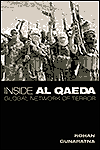|
|
Wahi: The
Supernatural Basis of Islam
Part VI -
Dr.
Somersí diagnosis of Mohammedís mental condition (2)
Dr. Koenraad ELST
[Editor's Note: Kashmir Herald is honored to have Dr. Koenraad ELST
write a series of articles exclusively for Kashmir Herald. His series of
5 exclusive articles on "The Supernatural Basis of Islam" will be
published exclusively here on Kashmir Herald.]
Of all the
founders of religions, none has left a more detailed biography than the Prophet
of Islam. So, what useful information about Mohammedís psyche can be distilled
from the core texts of Islam in order to give more body to our suspicion of a
paranoid condition?
About his
childhood (admittedly the less public part of his life and hence less likely to
yield information that was widely remembered), a few strange data emerge which
can be interpreted as prodromes or pre-symptoms. As a three-years-old, he
was found lying on the ground, pale and in shock, and he complained to his
foster-parents (townspeople often put their children in the care of poor country
folk) that two white-clad men had come and opened his belly, looking for
something. His foster-mother Halima even considered returning him to his real
mother, not wanting to bear the responsibility if something went wrong with the
boy, and she opined to her that the boy might ďhave a jinnĒ or ghost. As
indications of a latent mental problem, this is still pretty vague, but this
much is clear that even as a boy, Mohammed was noticed as a special case.
When he
became a young man and his vital powers were strong, these strange traits were
not in evidence, but as he entered middle age, they returned. In the years
preceding the start of the Quranic revelations, we know that his wife Khadija
thought he had the ďevil eyeĒ. For this reason, she sent him to exorcists for
treatment. This again we only know in very general terms, but it corroborates
the suspicion that Mohammed was predisposed to developing a mental problem, and
that his contemporaries were aware of his unusual psychic complexion. When the
prophetic trances became really serious, involving the vision of the archangel
Gabriel, Khadija took him to the godman (but not psychiatrist) Waraqa ibn Nawfal,
who certified the genuineness of Mohammedís visions. From that point onwards,
her supportive attitude to her husbandís initially desperate attempts to come to
terms with his trances took on the character of a folie ŗ deux: though
not afflicted herself, she went along with his self-delusion. She became the
first believer, the first one to surrender (Islam) her common-sense
judgment and take his claims as true.
Intolerance as a symptom
More than
these corroborative indications, however, it is the contents of Mohammedís
hallucinations which clearly mark him as a paranoia patient. A loud voice
localized in heaven or in a gigantic heavenly person speaks to him in the second
person: you are the prophet, chosen to convey the words of the Creator of
the Universe. He is given a uniquely central role in the cosmic scheme of
things: Godís final spokesman, the rightful ruler of mankind as Godís
vice-regent on earth, mediator for sinful mortals on the impending Day of
Judgment.
The
disproportion between his new self-perception and his actual social status as an
ordinary businessman and later as a derided cult leader was unbearable. In fact,
intolerance of othersí scepticism, along with vengefulness, is a typical trait
of paranoia patients. And so, we find Mohammed singling out each of his critics
for assassination or execution. Not that other, more regular tyrants havenít
executed critics, but it fits Mohammedís paranoid personality and only the
non-occurrence of his campaign of vengeance against his doubters would have
given us reason to doubt the diagnosis of paranoia. Incidentally, not a few of
these other tyrants may also have exhibited traces of paranoia, a condition
which (unlike schizophrenia and other psychopathological syndromes) is not
incompatible with worldly success. Megalomania, in particular, often provides a
strong motivation for the climb to centrality and power.
Physical
basis of mental problem?
Mohammedís
megalomania may partly have been an overcompensation for the misery he had
suffered, the early death of his parents and of his little sons. Yet, this
purely psychological explanation of the Freudian type cannot fully explain the
strange phenomena surrounding the development of his delusion: the
hallucinations and their neurological infrastructure. The denial of physical
determinants in favour of purely socio-psychological explanations (for problems
ranging from poor school performance to impotence), so popular from Freud down
to the 1970s, has given way to a restored respect for the materiality of the
human being: as a conscious subject, he may establish his freedom by skilfully
sailing on the sea of his material being, but he is affected by its storms,
which are not of his own making. The immediate impact of psychotropic drugs on
oneís mental condition, for better or for worse, provides experimental proof for
the relative materiality of our minds.
Therefore,
it may be apt to search for physical problems underlying the Prophetís mental
troubles. Of Mohammedís physical traits, one which draws the attention is that
he suffered of chronic headaches, which he tried to remedy by bleeding himself
in two veins in his neck. While in itself not enough to indicate a brain
problem, it certainly fits that picture once more indications are found.
The mention
of his falling on the ground once during a trance was earlier interpreted as an
indication of epilepsy, e.g. by the Byzantine author Theophanes in his
Chronographia. But this is clearly unsatisfactory, not only because epilepsy
is not typically accompanied by a permanent self-delusion, but mainly because
one of its typical symptoms is the complete forgetfulness about even the
occurrence of an epileptic fit after the recovery. Paranoid (or similar)
hallucinations, by contrast, leave a very strong impression on the mind.
Closer to
an explicit symptomatology is Mohammedís own description of the physical
sensations accompanying his trance. During the initial revelations, he felt the
angelís presence exerting an enormous, suffocating pressure on him. To Abdullah
ibn Umar he once described the sensations typically accompanying the trance:
loud noise, being hit by a mighty blow, feeling outside himself. The intensity
of the sound was unbearable to his oversensitive ears (or rather his auditory
brain centre), which is also why he disliked live music, a dislike later
emulated by Padeshah Aurangzeb and Ayatollah Khomeini as a matter of piety. Ibn
Saíd records the Prophetís words: ďRevelation comes to me in two ways. Sometimes
Gabriel comes and speaks to me from man to man, but I forget what he says then.
But sometimes he comes to me with the sound of a bell, like the roaring of many
waters, so that I get into confusion. But what is revealed to me in this manner
never lets go of me again.Ē
This
indicates an identifiable neuropathological basis for Mohammedís hallucinations.
As a hypothetical physiological explanation of Mohammedís mental problems, Dr.
Somers suggests that very near the main sensory (auditive and visual) nerves in
the mid-brain and on the front part of his pituitary gland, Mohammed had
developed a tumour. But this is more speculative than the well-attested
psychopathological diagnosis of Mohammedís paranoia condition. Future
researchers may determine more definitely what we must leave as a mere
interesting hypothesis for now. Mohammedís paranoia, by contrast, is an obvious,
widely attested and diagnostically articulate fact.
(to be
concluded)
[Click here for Part I]
[Click
here for Part II]
[Click
here for Part III]
[Click
here for Part IV]
[Click here for Part V]
[Born in Leuven, in the
year 1959, Koenraad Elst grew up in the Catholic Community in Belgium.
He was active for some years in what is known as the new Age movement,
before studying at the famed Catholic University of Leuven (KUL). He
graduated in Chinese Studies, Indo-Iranian Studies and Philosophy. He
earned his doctorate magna cum laude with a dissertation on the politics
of Hindu Revivalism.
He took courses in Indian
philosophy at the Benares Hindu University (BHU), and interviewed many
Indian leaders and thinkers during his stay in India between 1988 and
1992. He has published in Dutch about language policy issues,
contemporary politics, history of science and Oriental philosophies; in
English about the Ayodhya issue and about the general religio-political
situation in India.
A few of his latest
books are:
-
Who Is a Hindu? (2002)
-
Ayodhya: The Case against the Temple (2002)
-
The Saffron Swastika: The Notion of 'Hindu Fascism' (2001)
-
Decolonizing the Hindu Mind (2001)
-
Gandhi and Godse (2001)
-
Negationism in India: Concealing the Record of Islam,
-
Ram Janmabhoomi vs. Babri Masjid, and
-
Ayodhya
and After.
While doing research in
Indian philosophy at Benares Hindu University, he started taking an
interest in the ongoing Rushdie and Ayodhya controversies and the larger
debate on secularism. He published several books on the historical
Ayodhya file. He is currently working
as a free-lance scholar and columnist.] |


